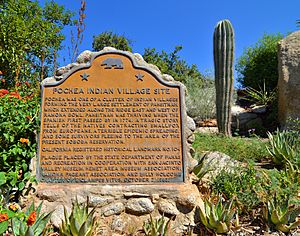Pochea facts for kids
Quick facts for kids Pochea Indian village site |
|
|---|---|

Pochea Indian village site marker
|
|
| Location | Ramona Bowl, 27400 S Girard Street, Hemet, California |
| Built | Prehistory – outbreak 1774 |
| Designated | March 29, 1933 |
| Reference no. | 104 |
| Lua error in Module:Location_map at line 420: attempt to index field 'wikibase' (a nil value). | |
The Pochea Indian village site was once home to the Pochea Indians. This important historical place is located in what is now Hemet, California, in Riverside County, California.
The Pochea village was part of a larger group of indigenous peoples of California known as Pahsitnah. On March 29, 1933, the site was recognized as a California Historic Landmark (No. 104). Today, you can find the village site at the Ramona Bowl.
In 1774, an explorer named Juan Bautista de Anza and his group visited the Pochea village. Sadly, someone in Anza's group carried a sickness that spread to the Pochea people. Many became ill, and some survivors moved to the Soboba Reservation, where the Soboba Band of Luiseno Indians live today.
Contents
Exploring the Land
Juan Bautista de Anza's Expedition
Juan Bautista de Anza led an important trip on January 8, 1774. His goal was to find a land route from Mexico to California. He traveled with soldiers, priests, and many animals like mules, cattle, and horses.
Anza's group crossed the Sonoran Desert. They went around the Gila River to avoid attacks from other groups. Eventually, they reached the Colorado River at a place called the Yuma Crossing. This was one of the only ways to cross the river. There, they met the friendly Quechan (Yuma) Indians. These people were growing their own food using irrigation and already had horses and other crops.
A Long Journey
After crossing the Colorado River, Anza's group traveled through what is now the Imperial Valley. They continued northwest until they reached Mission San Gabriel Arcángel, near where Los Angeles, California is today. This first trip to find a route into California took Anza about 74 days.
On his way back, Anza took a different path. This return trip was much faster, taking only 23 days. Along the way, he met several peaceful farming tribes who used irrigation systems near the Gila River.
Historical Marker
What the Marker Says
A special marker at the Pochea Indian village site tells its story. It reads:
- NO. 104 SITE OF INDIAN VILLAGE OF POCHEA – Pochea was one of a cluster of Indian villages forming the very large settlement of Pahsitnah, which extended along the ridge east and west of Ramona Bowl. Pahsitnah was thriving when the Spanish first passed by in 1774. A tragic story tells of the natives contracting smallpox from Europeans, a terrible epidemic spreading, and some survivors fleeing to the area of the present Soboba Reservation.
See also

